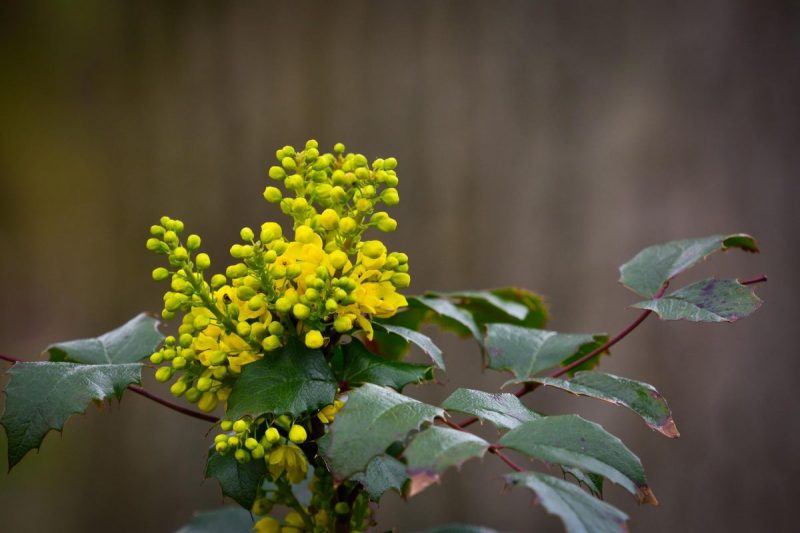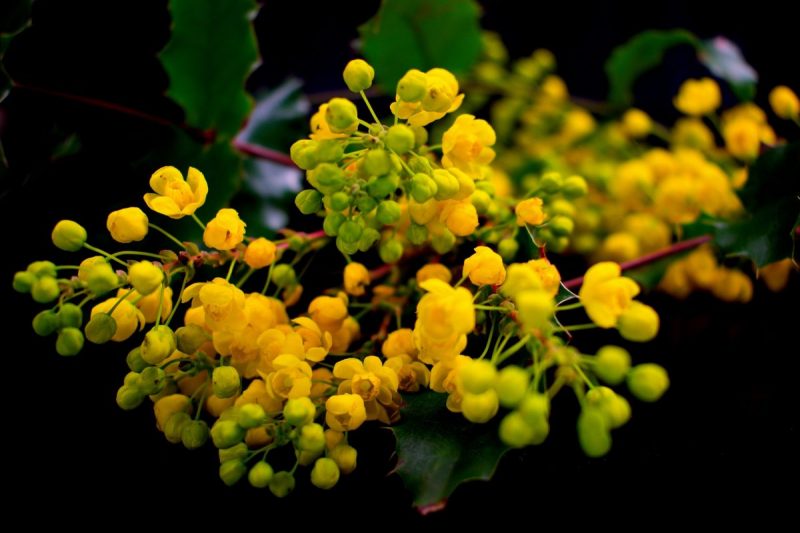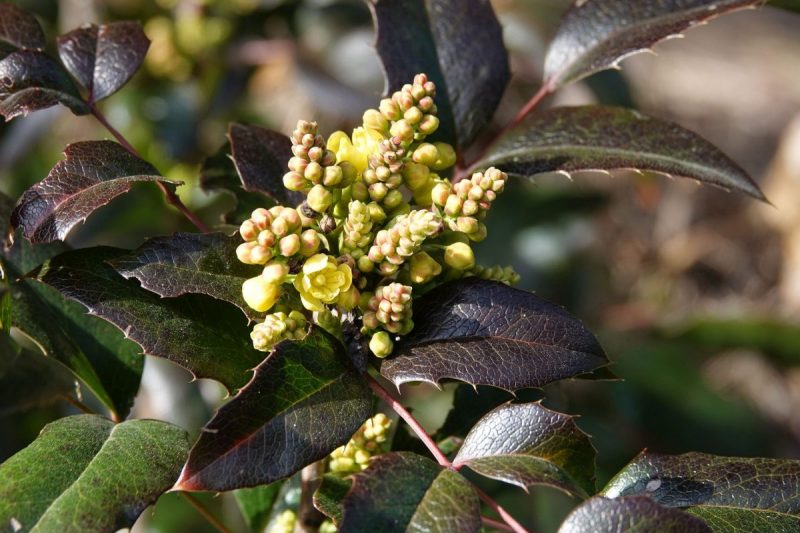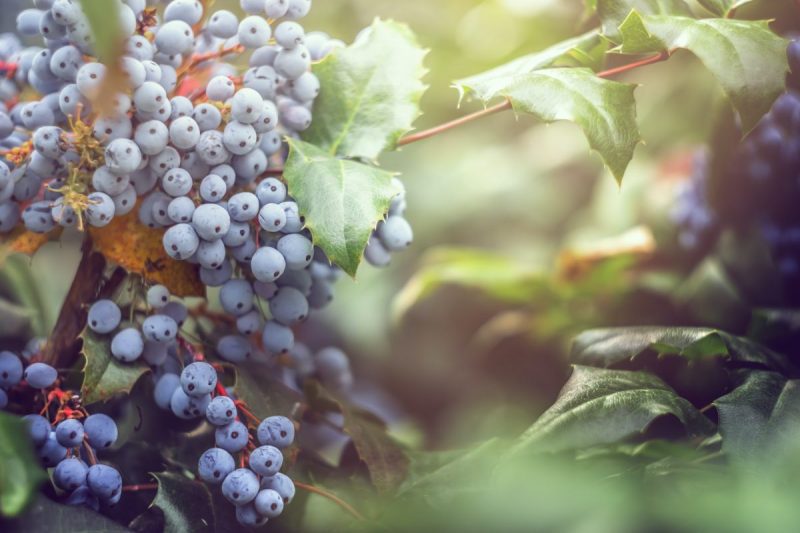Mahonia, planting guide and care work

Mahonia (Mahonia spp.) is an ornamental, evergreen shrub, which is part of the Berberidaceae family, originating from the North and Central America and Asia. Mahonia stands out for its yellow inflorescences, as well as its evergreen foliage, the overall appearance of the plant and its dark blue fruits.
The inflorescence is composed of bell-shaped flowers, fragrant, clustered in racemes. The fruits are represented by berries, gathered in bunches, similar to grapes. The leaves are imparipinnate, persistent, dark green, with a spiny edge, similar to Ilex leaves. Due to its overall appearance, Mahonia is often used in landscaping parks and gardens.
Mahonia – species and varieties
The Mahonia genus includes approximately 70 species and several cultivars and hybrids. Among the most popular we mention:
- Mahonia aquifolium ‘Apollo’: a shrub with green and glossy leaves, which take on a purple hue during the winter and with numerous, yellow flowers, gathered in bunches;
- Mahonia eurybracteata ‘Soft Caress’: it is small, with thin and elongated leaves and yellow flowers that can appear starting in August. It is suitable for flowerpots;
- Mahonia x media ‘Charity’: it grows vertically, up to 4 meters high. It has compound, lanceolate leaves and small, cup-shaped flowers, arranged in terminal, straight, upwards-oriented racemes;
- Mahonia x media ‘Winter Sun’: a medium-sized shrub, with vertical growth. It has long, spiny leaves and small, yellow flowers that appear during the cold season.



Environmental conditions
Light. Mahonia species can tolerate both direct sunlight and shade, but they grow well in partial shade. Placing them in completely shaded spaces can cause an elongated growth and a reduced number of flowers.
Temperature. It is a cold-resistant species. However, in areas with very low temperatures during the winter, it is recommended to protect the roots of the plant by covering the surrounding soil with a layer of mulch.
Soil. It grows well on most types of soil, provided that it is light, well-drained and damp.
Mahonia – Care
Watering. In the first year after planting, it requires regular watering, so that the soil is damp. Mature plants tolerate periods of drought and need watering only on hot days. Mahonia is a species sensitive to excessive moisture in the soil.
Fertilizing. The plants react well to the application of fertilizers. A slow-release fertilizer can be used in spring.
Recommended products
-
You can find products on a different store
Change Store -
You can find products on a different store
Change Store -
You can find products on a different store
Change Store -
You can find products on a different store
Change Store -
You can find products on a different store
Change Store -
You can find products on a different store
Change Store -
You can find products on a different store
Change Store -
You can find products on a different store
Change Store -
You can find products on a different store
Change Store -
You can find products on a different store
Change Store -
You can find products on a different store
Change Store -
You can find products on a different store
Change Store -
You can find products on a different store
Change Store -
You can find products on a different store
Change Store -
You can find products on a different store
Change Store -
You can find products on a different store
Change Store -
You can find products on a different store
Change Store -
You can find products on a different store
Change Store -
You can find products on a different store
Change Store -
You can find products on a different store
Change Store -
You can find products on a different store
Change Store -
You can find products on a different store
Change Store -
You can find products on a different store
Change Store -
You can find products on a different store
Change Store
Propagation. Mahonia can be propagated by cuttings, seeds or by dividing the bush.
Propagation by cuttings is the most accessible method. The cuttings can be harvested at the end of summer – beginning of autumn, before flowering.
Pruning. It is easy to take care of this species and it does not require regular pruning. However, if it is necessary, it can be carried out in the spring, when the danger of frost has passed. You can remove dry, diseased, damaged branches, or those that grow improperly and give the plant a “crowded” appearance.
Recommended products
-
You can find products on a different store
Change Store -
You can find products on a different store
Change Store -
You can find products on a different store
Change Store -
You can find products on a different store
Change Store -
You can find products on a different store
Change Store -
You can find products on a different store
Change Store -
You can find products on a different store
Change Store -
You can find products on a different store
Change Store -
You can find products on a different store
Change Store -
You can find products on a different store
Change Store -
You can find products on a different store
Change Store -
You can find products on a different store
Change Store -
You can find products on a different store
Change Store -
You can find products on a different store
Change Store -
You can find products on a different store
Change Store -
You can find products on a different store
Change Store -
You can find products on a different store
Change Store -
You can find products on a different store
Change Store -
You can find products on a different store
Change Store -
You can find products on a different store
Change Store -
You can find products on a different store
Change Store -
You can find products on a different store
Change Store -
You can find products on a different store
Change Store -
You can find products on a different store
Change Store
Planting. It can be planted during the dormancy period (spring-autumn), when the soil is not frozen and the temperatures are positive. Plants with a root bale will be used.
Immediately after planting, it is recommended to administer a fertilizer that stimulates the formation of roots. These fertilizers help the plant to adapt more easily to the new conditions and to overcome the periods of stress.
Recommended products
-
You can find products on a different store
Change Store -
You can find products on a different store
Change Store -
You can find products on a different store
Change Store -
You can find products on a different store
Change Store -
You can find products on a different store
Change Store -
You can find products on a different store
Change Store -
You can find products on a different store
Change Store -
You can find products on a different store
Change Store -
You can find products on a different store
Change Store -
You can find products on a different store
Change Store -
You can find products on a different store
Change Store -
You can find products on a different store
Change Store -
You can find products on a different store
Change Store -
You can find products on a different store
Change Store -
You can find products on a different store
Change Store -
You can find products on a different store
Change Store -
You can find products on a different store
Change Store -
You can find products on a different store
Change Store -
You can find products on a different store
Change Store -
You can find products on a different store
Change Store -
You can find products on a different store
Change Store -
You can find products on a different store
Change Store -
You can find products on a different store
Change Store -
You can find products on a different store
Change Store
Diseases and pests
It can be affected by diseases such as Rust and Powdery mildew. Among the pests, you can find the European fruit lecanium, wooly apple aphids and thrips.
Additionally
- The growth rate differs depending on the species. Usually Mahonia has a slow but steady growth;
- The plant is suitable for urban areas, being resistant to pollution;
- Mahonia blooms from winter until early spring.















































































































































































































































































































































































































































